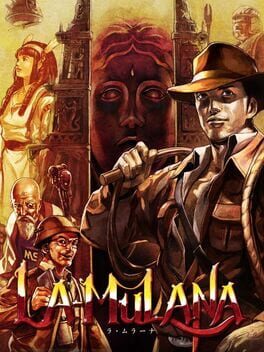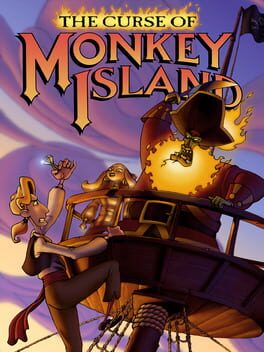jen_thehuman
2 reviews liked by jen_thehuman
La-Mulana
2012
La-Mulana is a terribly frustrating game that feels like an exercise in reaching the limits of unclear and obtuse design while maintaining a consistent internal logic. It wants to feel unfair while always having a solid justification for doing so. It's an interesting style exercise that makes the game near unplayable at times but also makes it extremely memorable.
It could be described as an early "note-taking adventure game". Titles in that genre usually try to make the player feel clever for inferring solutions to puzzles organically, which requires a very precise design to convey the right clues at the right time. Clues should lead to one another and then to rewarding discoveries, forming a graph structure that the player has fun untangling.
The La-Mulana developers seem to have tried to maximize how complex this graph of clues can be without leaving any disconnected, unfair puzzles, always leaving the tiniest breadcrumbs toward a solution. No matter how difficult a leap in logic can be, you can always connect it to a hint in the world. While you're unlikely to beat the game without outside help, even restoring to a walkthrough can be enjoyable, as trying to reverse engineer the intented path and the designer's intentions can be intellectually challenging.
It makes for a game that's often more fun to think about than it is to play. Writing down notes, collecting information and trying to piece it everything together is satisfying. The game's music and gameplay feedback are solid enough to make the play time engaging, but it's so easy to waste hours while hunting for the next crumb of progress. The platforming and combat do their job as palette cleansers between the puzzles, without standing out much.
There are times where the game disappoints later on, as the search space for puzzles increases dramatically (I found the addition of a second type of breakable wall to be too much myself). There's a few more puzzle ideas which are repeated a few too many time and loose their surprise value. The game almost crumbles under it's own weight by the end, a lock-and-key scenarios grow in complexity with the size of the map. You have to accept that you will either give up in the back half and use outside hints, or spend triple digits hours before the end.
Even so, the game manages to be successful in it's goals even if it "defeats" you, and is interesting to play even with a walk-through open. Failing to beat a game can still be an interesting experience worth having, as long as you accept that defeat as a positive experience. I think that partially explain why this game has a large fan base who experienced it mainly through old let's plays.
Solving a puzzle usually leads to a release of tension and a feeling of satisfaction. La-Mulana loves to toy with that emotion by making rewards so tiny and obtuse that they themselves become a bigger puzzle. You often get excited for finding a clever solution, only to have your excitement cut short when your reward is more confusing than the puzzle you just solved. It's a playfully sadistic game.
It feels struggling to open a package with your fingernails, and being devastated to find a smaller, more tightly packed box inside. And that feeling lasts until the last few hours of the game. There isn't a point where it feels "solved", you only get to feel like you cracked open the puzzle box once you hit the credits, or maybe later even. It never feels like you've cracked the whole thing open. You eventually come to see the game as a single entity, your antagonist to defeat, and the game's story manage to perfectly capture that with a clever late game twist. The "La-Mulana" temple as a whole is revealed to be the entity your are chasing after and need to defeat.
The puzzle box qualities of the level design make up for otherwise unsatisfying progression items. You may not get many interesting character upgrades, but it feels like the game world around you progresses and evolves as an indication of your progress. Destroyed walls, activated mechanisms and water flow all remind you of your progress. It's very satisfying and interesting, and helps sell this idea of the game world as a living being.
Even after a full playthrough, having given up and used tools about 6/8 bosses in, I struggle to piece every last detail together, and I appreciate the game as something I may return to years in the future for a refresher.
It could be described as an early "note-taking adventure game". Titles in that genre usually try to make the player feel clever for inferring solutions to puzzles organically, which requires a very precise design to convey the right clues at the right time. Clues should lead to one another and then to rewarding discoveries, forming a graph structure that the player has fun untangling.
The La-Mulana developers seem to have tried to maximize how complex this graph of clues can be without leaving any disconnected, unfair puzzles, always leaving the tiniest breadcrumbs toward a solution. No matter how difficult a leap in logic can be, you can always connect it to a hint in the world. While you're unlikely to beat the game without outside help, even restoring to a walkthrough can be enjoyable, as trying to reverse engineer the intented path and the designer's intentions can be intellectually challenging.
It makes for a game that's often more fun to think about than it is to play. Writing down notes, collecting information and trying to piece it everything together is satisfying. The game's music and gameplay feedback are solid enough to make the play time engaging, but it's so easy to waste hours while hunting for the next crumb of progress. The platforming and combat do their job as palette cleansers between the puzzles, without standing out much.
There are times where the game disappoints later on, as the search space for puzzles increases dramatically (I found the addition of a second type of breakable wall to be too much myself). There's a few more puzzle ideas which are repeated a few too many time and loose their surprise value. The game almost crumbles under it's own weight by the end, a lock-and-key scenarios grow in complexity with the size of the map. You have to accept that you will either give up in the back half and use outside hints, or spend triple digits hours before the end.
Even so, the game manages to be successful in it's goals even if it "defeats" you, and is interesting to play even with a walk-through open. Failing to beat a game can still be an interesting experience worth having, as long as you accept that defeat as a positive experience. I think that partially explain why this game has a large fan base who experienced it mainly through old let's plays.
Solving a puzzle usually leads to a release of tension and a feeling of satisfaction. La-Mulana loves to toy with that emotion by making rewards so tiny and obtuse that they themselves become a bigger puzzle. You often get excited for finding a clever solution, only to have your excitement cut short when your reward is more confusing than the puzzle you just solved. It's a playfully sadistic game.
It feels struggling to open a package with your fingernails, and being devastated to find a smaller, more tightly packed box inside. And that feeling lasts until the last few hours of the game. There isn't a point where it feels "solved", you only get to feel like you cracked open the puzzle box once you hit the credits, or maybe later even. It never feels like you've cracked the whole thing open. You eventually come to see the game as a single entity, your antagonist to defeat, and the game's story manage to perfectly capture that with a clever late game twist. The "La-Mulana" temple as a whole is revealed to be the entity your are chasing after and need to defeat.
The puzzle box qualities of the level design make up for otherwise unsatisfying progression items. You may not get many interesting character upgrades, but it feels like the game world around you progresses and evolves as an indication of your progress. Destroyed walls, activated mechanisms and water flow all remind you of your progress. It's very satisfying and interesting, and helps sell this idea of the game world as a living being.
Even after a full playthrough, having given up and used tools about 6/8 bosses in, I struggle to piece every last detail together, and I appreciate the game as something I may return to years in the future for a refresher.
Some of the puzzles in The Curse Of Monkey Island are utterly incomprehensible. Occasionally, the graphical limitations of the game obscure items that are useful from those which are simply part of the mise-en-scéne. Other puzzles require such an outlandish combination of items that could only be discovered by indiscriminately attempting to unite literally anything in Guybrush’s inventory. It makes the game a frustrating experience at even the best of times, and that is to say nothing of The Curse Of Monkey Island’s clunky, tedious pirate ship battles in the third chapter. However, passion is infectious, and it is impossible not to absorb the enthusiasm that has gone into making this game. From the anachronistic humour and charming ensemble of characters to the hand-crafted background art, from Michael Land's gorgeous soundtrack to the vivacious voice performances, nobody can accuse The Curse Of Monkey Island of being made with anything but love. This winning personality carries the game through even the rockiest of waters.

